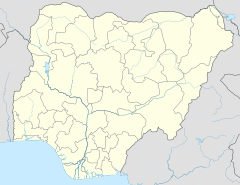Lower Kaduna-Middle Niger Floodplain
| Lower Kaduna-Middle Niger Floodplain | ||
|---|---|---|
|
|
||
| Location: | Nigeria | |
| Specialty: | Niger State , Kwara | |
| Next city: | Pategi , Gbako , Ilorin , Minna | |
| Surface: | 2290.54 km² | |
| Founding: | 2008 | |
The Lower Kaduna-Middle Niger Floodplains are a protected area under the Ramsar Convention in the Nigerian states of Niger and Kwara . It occupies an area of 2290.54 km² in the administrative area of the greater municipalities of Pategi and Gbako at an average altitude of 130 meters above sea level. On April 30, 2008, it was included in the Ramsar Convention's list of wetlands of international importance. It is considered to be an important wetland in the ecoregion of the Guinea savannah and it was an Important Bird Area even before it was nominated as a Ramsar area .
The sanctuary lies on a wide plain at the confluence of the Niger and Kaduna rivers . It extends from the course of the Niger River from Jebba to Baro and on the Kaduna from the Wuya Bridge along the A1 highway from Jebba - Bida to Pategi. The protected area forms the core zone of a wetland area that extends from the abdominal plateau to the highlands of the Yorubas , and along the course of the Niger River to the rainforest areas in southern Nigeria. It consists of a succession of wetlands, shallow swamps, ponds and lakes, in the floodplains of the two rivers; called in Hausa Fadama ; and sandbanks and rapids , some of which are framed by kilometers of steep walls, along the rivers. The flood season, which is called the white flood until November, starts in the months of August to October. From December to March the flood is called the black flood , as the water of the Niger appears much clearer and more transparent. The highest water level in the wetlands is reached in February, and it drops continuously until July, when the water level is lowest.
The climate in the region is described as tropical and humid , with a pronounced separation of rainy and dry periods, with the lowest daily mean temperatures in August / September of 26 ° C and maximum temperatures in March, April and May of 35 ° C. The rainy season extends from May to October and is determined by the rainfall regime of the West African monsoons . The average annual rainfall varies with a west-east gradient of approx. 1012 mm in Jebba and 1212 mm in Bida, but a meridional gradient is not very pronounced.
The soils in these wetlands are called alluvial alluvial soils , which lie on the Nupe sandstone that was formed in the Cretaceous period . The regeneration capacity of the wetlands depends on the surface transformation processes of erosion and sedimentation in the flood season. However, the construction of the Kainji and Shiroro reservoirs affected the processes, so that the extent of the floodplains has decreased since the 1970s and parts of the wetlands can only partially benefit from the floods. The once 12 km² large Ndakolowu Lake (12 km northeast of Jebba), for example, reduced its water surface to a few ponds until the 1990s. Accordingly, typical inhabitants of the Guinea savannah flora displaced typical plant species of the wetlands into larger areas. Another negative impact comes from the increase in population and intensive agriculture, for example the region is considered an important growing area for rice and sugar cane in Nigeria.
Gallery forests, in which the Mitragyna inermis is a dominant species, grow along the rivers and intact floodplain areas . The Nymphaea Lotus , Echinochloa pyramidalis , Echinochloa stagnina , Cyperus papyrus and Vossia cuspidat grow on the open water surfaces and on the banks .
Of the avifauna , around 15 endangered bird species occur as breeding birds in this area . In 1989 and 1996 about 15,000 animals were counted from the rose spint ( Merops malimbicus ). Others are of the black-throated honey guide ( Indicator indicator ), Hartlaub duck ( Pteronetta hartlaubii ), Busch Sperling ( Petronia dentata ), black-rumped waxbill ( Estrilda troglodytes ) and the cry Hornvogel ( Bycanistes fistulator ).
Important fish species in the rivers belong to the genera Gymnarchus , Clarias , Heterotis and the giant perch (Latinae). In the wetlands live the wound catfish ( Heterobranchus longifilis ), Malapterurus and representatives of the Auchenoglanidinae , Claroteidae and Distichodontidae .
Individual evidence
- ↑ The Annotated Ramsar List: Nigeria ( Memento of October 12, 2013 in the Internet Archive ) (English)
- ↑ NG012Lower Kaduna - Middle Niger flood-plain on BirdLife International (English)
- ↑ Information Sheet on Ramsar Wetlands (RIS) - 2006-2008 Version ( Memento from November 2, 2013 in the Internet Archive )
- ↑ 4.2 THE NIGER / KADUNA RIVER BASIN FAO.Org (English)
